Minimally Invasive Heart Surgery.
- Minimally invasive heart surgery is also known as keyhole surgery.
- It is a conventional operation performed on or inside the heart using a small incision. The surgeon also uses specialized instruments.
Surgery Performed Through Minimally Invasive Approach
(Previously Done Using Traditional Open Method )
- Mitral valve repair/replacement
- Aortic valve replacement
- Coronary artery bypass surgery(for selected patients)
- Bentall’s procedure(for selected patients)
- Ascending aortic arch replacement(for selected patients)
- Birth defect such as atrial septal defect or pda
Who Is The Candidate For Minimally Invasive Surgery?
- Your surgical team will carefully assess your suitability for minimally invasive surgery. Your surgeon will decide the best approach for you based on several factors, including the type of heart disease you have and how severe it is, your age, medical history and lifestyle, as well as the results of tests conducted prior to surgery.
Traditional Heart Surgery
- Traditional heart surgery uses an incision through the middle of your chest, cutting the breast bone. The incision measures 6 to 8 inches in length.
- This is the safest and most commonly used incision worldwide for patients who need complicated heart surgeries, reoperation, multiple coronary artery bypass procedures or complex aortic procedures.
Types Of Minimally Invasive Heart Surgeries
Dr Devender Singh has been performing minimally invasive heart surgeries for a decade. The first surgeries of this type were mitral and aortic valve surgeries. Now, a wide range of procedures can be done using minimally invasive techniques for faster recoveries and are far more comfortable too for the patient.
Sometimes, minimally invasive surgery includes a partial sternotomy. This involves cutting a part of the breast bone. When possible, the surgeon can avoid cutting the breast bone and, instead, make one or more small incisions through muscles between the ribs. This technique is called a mini thoracotomy.
Incisions used in Minimally Invasive Heart Surgery
Partial sternotomy-through part of breast bone
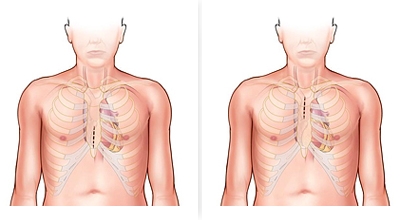
Used for mitral valve, tricuspid valve, atrial septal defect (asd), myxoma, ascending aorta and aortic valve surgeries.
A 3 to 4 inch long incision is made through the sternum, and the breast bone is separated in the area so that the surgeon can see the part of the heart that needs surgery.
- Used for mitral valve, tricuspid valve, atrial septal defect (asd), myxoma, ascending aorta and aortic valve surgeries.
Mini Thoracotomy
The surgeon avoids cutting through the breast bone and, instead, cuts into muscles between the ribs to reach the heart.
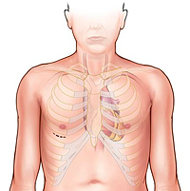
Used for mitral valve, tricuspid valve, asd, myxoma surgeries.
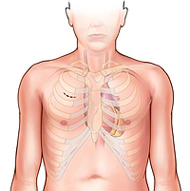
Used for aortic valve surgeries.
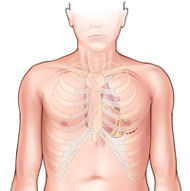
Used for coronary artery bypass surgery.
Minimally Invasive Cardiac Surgery Mitral Valve Replacement/Repair (Mics Mvr)
- With a minimal invasive approach, we use a 7 cm incision on the right side of the chest with sophisticated instruments to reach the mitral valve. Once the heart chambers are opened under cardio-pulmonary bypass, the procedure is the same as in a conventional open heart surgery.
Minimally Invasive Coronary Artery Bypass Surgery
- MICS CABG surgery is a safe and complete operation and is said to have revolutionised the way coronary surgery is performed. In this technique, the heart is approached through the side of the left chest through a small 7-8cm incision. This incision is placed under the nipple. The chest is entered between the ribs without cutting any bones and by splitting the muscles.
- With advanced instrumentation and techniques, we perform CABG with combination of artery and veins or total arterial depending on the coronary artery lesions. Since there is no cutting through any bone, the patients experience less pain and the chance of infection is very low.
Benefits Of Minimally Invasive Surgical Techniques
The Benefits Of Minimally Invasive Surgery Includes:
- Small incision
- Small scars
- Less pain
- Shorter hospital stay after surgery
- Lower risk of infection
- Lower risk of bleeding and blood transfusion
- Shorter recovery time and faster return to normal activities/work.
Recovery
After a successful minimal invasive surgery, you will probably be able to go home in 2 to 5 days after surgery. While you are in the hospital, a healthcare team will assist you and help you recover fully. When you are ready to leave the hospital, you will get instruction on your recovery and return to work, including guidelines for activity, driving, incision care and diet.
In general, it takes about 2 to 3 weeks before you will feel well enough to return to work (if your job doesn’t involve physical activities), resume driving and take part in most non-strenuous activities. You can usually get entirely back to normal routine in 3 weeks after surgery. It’s important to understand that everyone’s pace of recovery is different.
Healthy Living
To keep your heart healthy after surgery, it is important to make certain lifestyle changes and take your medications as per prescribed.
Important heart-healthy lifestyle changes for your quick recovery include:
- Quitting smoking
- Controlling high cholesterol
- Managing high blood pressure and diabetes
- Exercise Regularly
- Maintaining a healthy weight
- Eating a heart healthy diet
- Taking part in cardiac rehabilitation program, as recommended
- Following up with your doctor for regular visits.
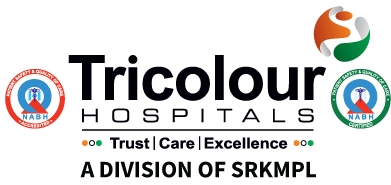

Leave a Reply